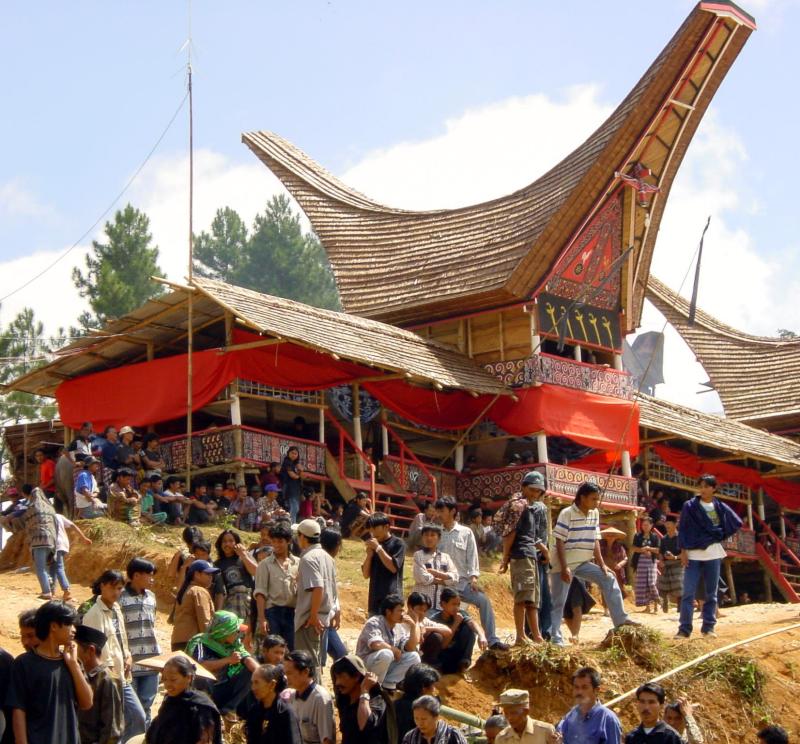
The beautiful red arch way is a burial site
Pandemic The Magic Bicycle, like an old Volkswagen beetle chugging away on fumes on a warm humid day, cycles up a 40 kilometer hill in the central mountain range. At a steady 10km an hour, for 4 hours we climb, climb, climb like a snake swirling though the dry arid sand. And with a long awaiting gust descend 9km light and fast with relief as if we had lost a layer of skin to climb again for an hour(11km) to finally arrive to the hill side village on Rantepoa in The Tana Toraja area of Sulawesi, Indonesia.

Pig on it’s way to his role in the ceremony
The contours of the mountains are as green as a tulip peddles. The hills are accented by colorful arching buildings that are beautiful decorated ritual burial sites. Arches that open upward with arms open to the beauty that surrounds the hill side. The folks in this region despite Christian missionizing have held strong to their traditional spiritual beliefs of animism; an ancient earth based shamanic religion that pre-dates Christianity. The center piece and focus of life here is the death ceremony, a 5 day festival of life, each day celebrating a new rite of passage into the afterlife.
The following morning after a long sleep I cycle out of town through the surrounding villages in the Tana Torajo region. As I stand at a cross roads straddling Pandemic The Magic Bicycle, bewildered, staring at a fading hand written map, a man stops on his motorcycle and stretches out his hand and says me chief, funeral ceremony and points down an intensely rocky dirt “road”. When the chief of an indigenous village in the middle of Indonesia invites you to his home to celebrate the focus of his life it is always best to smile, say thank-you and follow. So I did and bounced down the most unsuitable road for a bicycle, smiling so hard I thought my ears might break.

Ancestoral burial site of the very rich or magical
As I pedaled through the large brilliant multi-colored arch I am greeted by a bellowing of drums, chanting and music pumping through loudspeakers that appear to be mounted onto any piece of bamboo strong enough to bear the weight. A large crowd is gathered under several traditionally hand painted archways on a soft muddy grassy knoll that has seen its fair share of parades. Pigs are squealing as men carry them off lashed by their legs to sticks. They are being prepared for their role in the celebration.
Men and women, the frail, the elderly and the young are dressed in traditional golden threaded garments that sparkle with a well sewn festive charm. They are holding a long red cloth banner in the air, with arms stretched high they march, dance, parade and sing. They are the family of the deceased women and they are taking her spirit through the village for her last time to all her favorite places. A paper mache replica of the women is seated in a chair; she is being carried in the air by her young male family members. The sacrificial buffalo that end the week long celebration are the caboose. Their horns are adorned in silky red and yellow golden cloth; they follow in sequence through the excited streets.
Upon the mourners return to the grassy knoll, the replica of the women is paraded up several wooden stairs to her final resting place, a wooden arched tomb that sits on stilts above the village. The family although in morning is celebrating, they continue to sing, laugh and cheer. As the music drifts from the air, I exit under the village gate, and continue to pedal south pondering if National Geographic may of seen such a thing.
